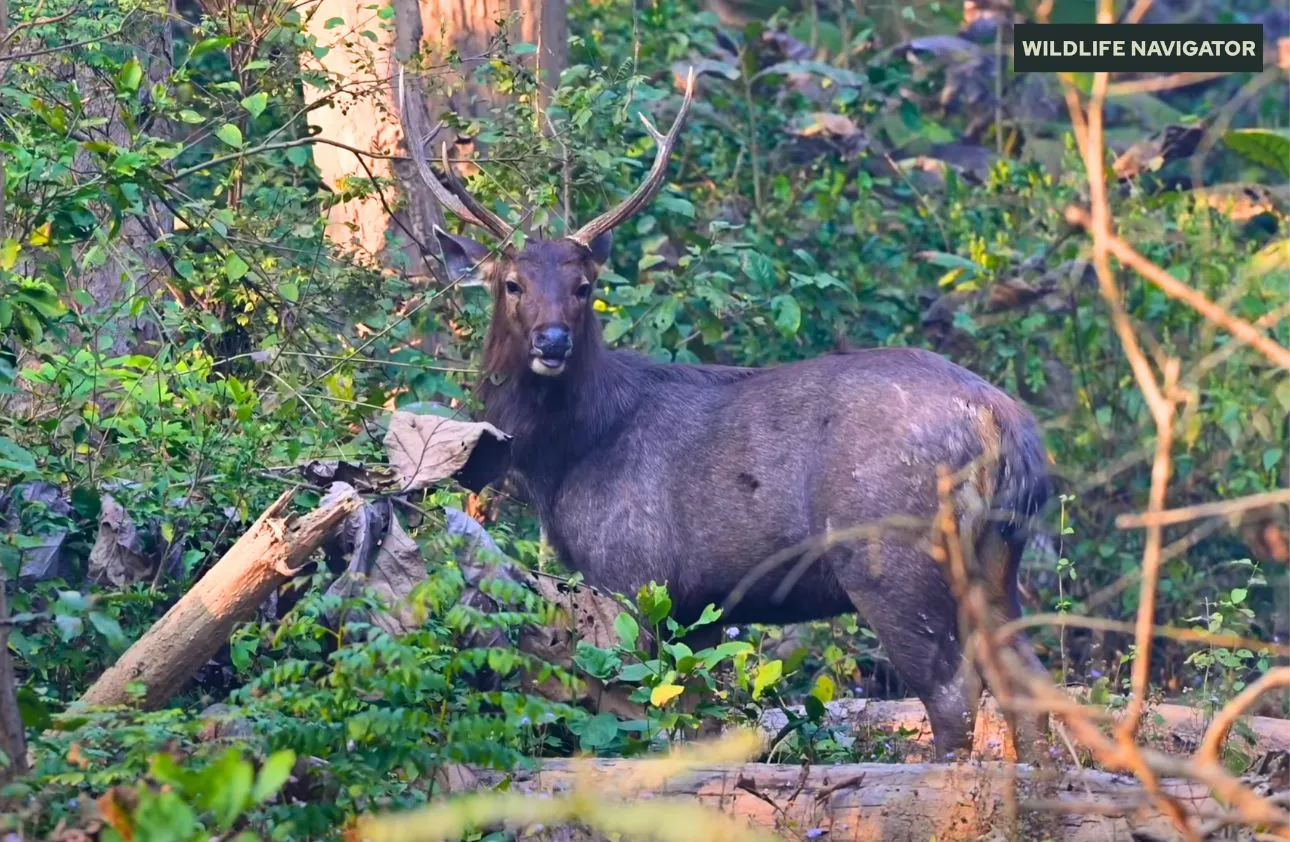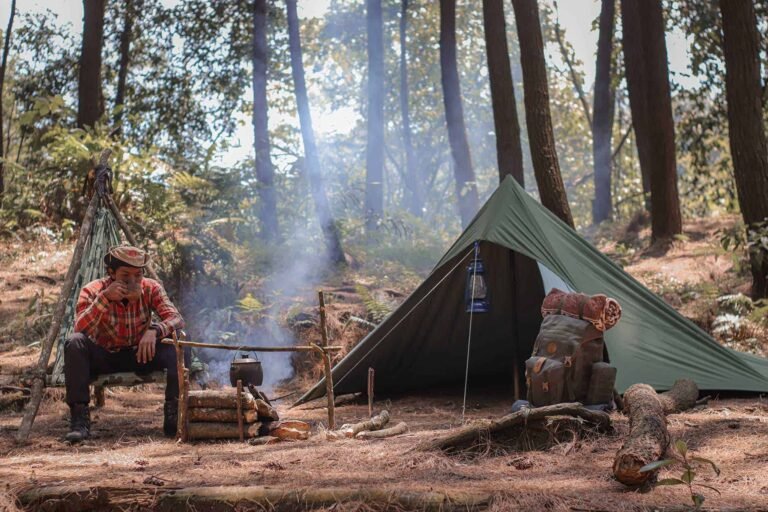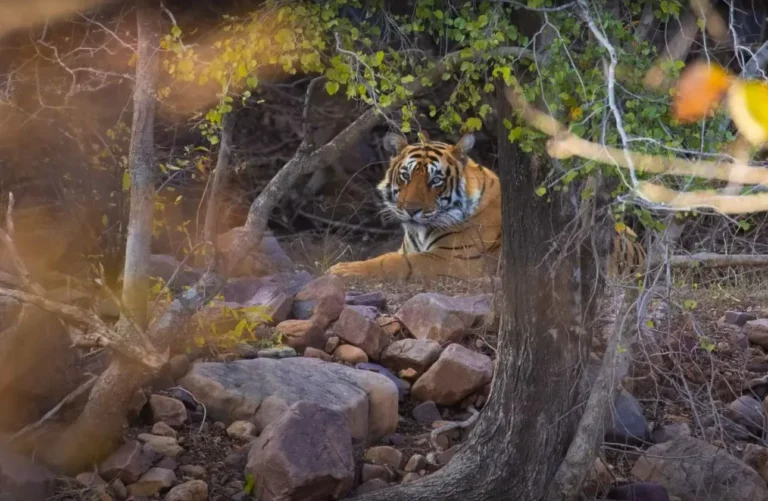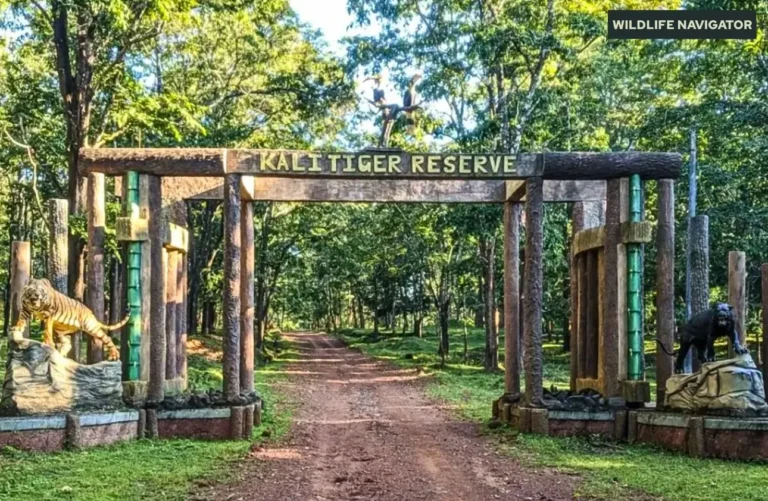Sambar Deer – India’s Largest Deer Species | Habitat, Behavior & Wildlife Guide

The Sambar deer (Rusa unicolour) is one of the largest deer species found in India and across Southeast Asia. Known for its imposing size and distinctive dark brown coat, the Sambar deer plays a vital role in forest ecosystems as a primary prey species for apex predators like tigers and leopards. Their presence not only maintains the balance of the food chain but also contributes to seed dispersal, helping sustain dense forest habitats.
Sambar deer are a favourite among wildlife enthusiasts and photographers due to their majestic appearance and elusive behaviour. Often seen grazing in the early mornings or late evenings, these deer bring a sense of wilderness and serenity to the forests they inhabit. From the lush grasslands of Kanha to the dense jungles of Periyar and Bandhavgarh, Sambar deer are a symbol of India’s rich biodiversity.
Whether you are a nature lover, a wildlife photographer, or a curious traveller, understanding the Sambar deer opens a window into the fascinating dynamics of India’s forests.
Scientific Classification and Physical Description
The Sambar deer (Rusa unicolour) belongs to the family Cervidae, which includes all deer species. Its scientific classification is as follows:
- Kingdom: Animalia
- Phylum: Chordata
- Class: Mammalia
- Order: Artiodactyla
- Family: Cervidae
- Genus: Rusa
- Species: Rusa unicolor
This classification places the Sambar among large, even-toed ungulates known for their antlers and herbivorous diet. As one of the largest deer species in India, the Sambar is particularly notable for its impressive physical characteristics.
Physical Appearance
Sambar deer are robust and muscular, with adult males typically standing 102–160 cm (3.3–5.2 ft) at the shoulder and weighing between 100–180 kg, while females are slightly smaller. Their coat is coarse, shaggy, and dark brown, which helps them blend seamlessly into dense forest habitats.
One of the most striking features of male Sambar deer is their antlers, which usually have three tines on each side. These antlers are shed and regrown annually, growing larger as the deer matures. Females generally do not have antlers. Both sexes have a bushy tail and a dark mane along the neck and shoulders, which becomes more pronounced during the rutting season.
Sambar deer also have long, sturdy legs adapted for running across uneven terrain and leaping over obstacles. Their large ears and keen sense of smell allow them to detect predators from a distance, making them both alert and elusive in the wild.
In addition to their size and antlers, Sambar deer possess a slow, deliberate gait, but can sprint up to 50 km/h when threatened. Their ability to move silently through dense forests makes them a challenging yet rewarding sight for wildlife enthusiasts and photographers alike.
Habitat & Distribution
The Sambar deer is a highly adaptable species, thriving in a variety of forested habitats across South and Southeast Asia. They are predominantly found in tropical and subtropical forests, grasslands, and hilly terrains, often near water sources like rivers, streams, and marshes, which are crucial for drinking and cooling off during hot weather.
Geographical Range
Sambar deer have a wide distribution, with populations spread across:
- India: From the Himalayan foothills in the north to the Western Ghats in the south, including national parks such as Kanha, Bandhavgarh, Periyar, Jim Corbett, and Sundarbans.
- Sri Lanka: Dense forests and wet zones harbour a stable population.
- Nepal and Bhutan: Found in forested hills and protected reserves.
- Southeast Asia: Including Thailand, Malaysia, Indonesia (Sumatra), and parts of Indochina.
Preferred Habitat
Sambar deer prefer dense vegetation, which provides cover from predators and a steady supply of food. They are commonly found in:
- Tropical deciduous forests – with mixed trees providing shade and forage.
- Evergreen forests – particularly in southern India and Sri Lanka.
- Grasslands and meadows – for grazing during cooler hours of the day.
Despite their preference for forests, Sambar deer are excellent swimmers and often inhabit areas near lakes or marshes. Their adaptability allows them to survive in regions with human activity, although they tend to avoid heavily populated areas.
Altitude Range
Sambar deer can thrive from sea level up to 3,000 meters in hilly or mountainous forests, making them one of the most versatile deer species in Asia. This altitude adaptability also helps them coexist with predators such as tigers and leopards across varied terrains.
Behavior & Diet
The Sambar deer is a fascinating creature, not only because of its size but also due to its unique behaviours and feeding habits. Understanding its behaviour helps wildlife enthusiasts, researchers, and photographers anticipate sightings in the wild.
Behavior
Sambar deer are generally nocturnal or crepuscular, meaning they are most active during the early morning and late evening hours. During the day, they prefer to rest in dense forest cover to avoid predators. Despite their size, Sambar deer are stealthy and elusive, moving silently through undergrowth with surprising agility.
- Social Structure: Sambar deer are mostly solitary, especially adult males. Females and young deer may form small herds of 3–5 individuals, often led by a dominant female. Males are territorial and may mark their area by rubbing antlers on trees and leaving scent marks.
- Communication: They use vocalisations, body postures, and scent markings to communicate. A loud bark or alarm call is often used to warn others of nearby predators.
- Swimming & Leaping: Sambar are strong swimmers and may cross rivers or wetlands to evade predators. Their long, muscular legs allow them to leap over obstacles and navigate rugged terrain efficiently.
Diet
The Sambar deer is a herbivore, feeding primarily on grasses, leaves, shoots, fruits, and shrubs. They are browsers and grazers, adjusting their diet based on seasonal availability:
- Monsoon Season: Fresh green shoots, tender leaves, and grasses dominate their diet.
- Dry Season: They feed on woody plants, bark, and fallen fruits to sustain themselves when foliage is scarce.
Sambar deer also play an important ecological role. By feeding on various plants and dispersing seeds through their droppings, they contribute to forest regeneration and biodiversity.
Predator Awareness
Despite their size, Sambar deer are prey for apex predators like tigers, leopards, and crocodiles. They rely on their alertness, camouflage, and swift movement to evade threats. They often remain silent and hidden during the day, venturing into open areas only when it’s safe.
Reproduction & Life Cycle
The Sambar deer follows a seasonal reproductive cycle that is closely tied to environmental conditions, ensuring the survival of the fawns in favourable seasons.
Mating Season
The rutting season for Sambar deer typically occurs from August to October in India, although this may vary slightly depending on geographic location. During this period:
- Males become highly territorial, marking their areas with antler rubs and scent secretions.
- Dominant stags engage in antler fights to establish supremacy and win the right to mate with receptive females.
- Vocalisations increase, with males often producing loud roars to attract females and warn rival males.
Gestation & Birth
- The gestation period lasts around 8 months, with fawns usually born in late spring or early summer, when food is abundant.
- Fawn Characteristics: Newborn fawns weigh approximately 6–8 kg and have a spotted coat, which provides excellent camouflage in forested habitats. These spots fade as the fawn grows older.
Growth & Development
- First Year: Fawns remain close to their mothers, learning to graze and navigate forests.
- Antler Development: Male fawns begin developing small antler buds within their first year, which grow larger with age.
- Maturity: Sambar deer typically reach sexual maturity at 3–4 years, although males may take longer to grow full-size antlers and establish territories.
Life Span
In the wild, Sambar deer can live up to 12–15 years, though predation and habitat pressures may reduce their average lifespan. In protected reserves with minimal human interference, some individuals may survive longer.
Parental Care
- Mothers are highly protective and conceal fawns in dense undergrowth while foraging.
- Fawns are often hidden for the first few weeks of life, returning to their mothers only for feeding.
- This strategy helps reduce predation risk and increases survival rates in forests teeming with predators.
Predators & Threats
Despite their large size and agility, Sambar deer are an important prey species in the forest ecosystem. They face threats from both natural predators and human-induced factors, which can significantly impact their populations.
Natural Predators
Sambar deer are prey for a variety of apex predators, especially in India’s national parks and wildlife reserves:
- Tigers: The Sambar is a primary prey species for tigers, providing the necessary protein for these big cats. Tigers often hunt them at night or during dawn and dusk when Sambar are most active.
- Leopards: Smaller and more stealthy predators, leopards often ambush Sambar, especially juveniles or weaker individuals.
- Dholes (Wild Dogs): Packs of dholes can successfully hunt Sambar deer in groups, targeting the vulnerable.
- Crocodiles: In regions with rivers and wetlands, such as the Sundarbans, Sambar deer may fall prey to crocodiles while drinking or crossing water bodies.
Human-Induced Threats
- Poaching: Sambar deer are hunted for meat, antlers, and hides in some regions, despite legal protections. Antlers are especially valued in traditional medicine and as trophies.
- Habitat Loss: Deforestation, urbanisation, and agricultural expansion reduce the available habitat for Sambar deer, forcing them into fragmented forests and increasing human-wildlife conflict.
- Road Accidents: Deer crossing highways near forested areas are vulnerable to vehicle collisions, which is a growing concern in areas adjacent to protected parks.
- Competition with Livestock: Grazing by domestic cattle in or near forests can limit food availability for wild herbivores like Sambar deer.
Ecological Importance
Despite these threats, Sambar deer are crucial to forest ecosystems:
- They serve as prey for apex predators, maintaining a balanced food chain.
- By grazing and browsing, they influence vegetation patterns, which benefits other wildlife species.
Conservation of Sambar deer not only ensures their survival but also helps safeguard the overall health of forest habitats across India and Southeast Asia.
Conservation Status
The Sambar deer (Rusa unicolour) is classified as “Vulnerable” on the IUCN Red List, highlighting the growing concern for its long-term survival. While populations remain stable in some protected areas, habitat loss, poaching, and human-wildlife conflict continue to pose serious challenges.
Protected Areas and National Parks
Sambar deer are protected in several national parks, wildlife sanctuaries, and tiger reserves across India and Southeast Asia. Key protected areas where Sambar populations thrive include:
- Kanha National Park, Madhya Pradesh – One of India’s best spots to observe Sambar deer in their natural habitat.
- Bandhavgarh National Park, Madhya Pradesh – Dense forests provide shelter and grazing grounds for large populations.
- Periyar Wildlife Sanctuary, Kerala – Sambar deer are frequently seen near water bodies, forming an essential prey base for tigers.
- Jim Corbett National Park, Uttarakhand – Home to healthy Sambar populations supporting predator-prey balance.
Conservation Efforts
- Legal Protection: Hunting of Sambar deer is prohibited under the Wildlife Protection Act of 1972 in India.
- Habitat Restoration: Efforts are ongoing to restore degraded forest areas and maintain grasslands to support herbivore populations.
- Anti-Poaching Measures: Forest departments and wildlife NGOs conduct patrols and surveillance to prevent illegal hunting.
- Community Awareness: Local communities are being educated about the ecological importance of Sambar deer and the benefits of wildlife tourism.
Importance of Conservation
Sambar deer are a keystone species in many forest ecosystems. Conserving them helps:
- Maintain a balanced food chain by supporting predator species like tigers and leopards.
- Promote forest regeneration through seed dispersal.
- Enhance biodiversity, ensuring the survival of other herbivores and dependent species.
While challenges remain, protected areas and conservation initiatives have helped stabilise Sambar populations in several regions, making them a success story for wildlife management in Asia.
Sambar Deer in Indian National Parks
The Sambar deer is a flagship species in India’s national parks and tiger reserves, serving as both a vital prey species for big cats and a favourite attraction for wildlife enthusiasts and photographers. Their widespread presence makes them an integral part of India’s rich forest ecosystems.
Key National Parks with Sambar Deer Populations
- Kanha National Park, Madhya Pradesh
- Known as one of India’s finest tiger reserves, Kanha hosts large Sambar herds.
- Visitors often spot them grazing in grasslands during early mornings and evenings.
- Sambar deer contribute to maintaining prey populations for Kanha’s tiger population.
- Bandhavgarh National Park, Madhya Pradesh
- With dense forests and open meadows, Bandhavgarh is ideal for observing Sambar deer.
- The park’s high tiger density relies on the Sambar as a primary prey species, highlighting its ecological importance.
- Periyar Wildlife Sanctuary, Kerala
- The lush forests and abundant water bodies of Periyar provide a perfect habitat for Sambar deer.
- Visitors on boat safaris can often spot deer drinking along the lake’s edge, a rare and beautiful sight.
- Jim Corbett National Park, Uttarakhand
- As India’s oldest national park, Corbett has thriving Sambar populations across its various zones.
- The park’s diverse terrain allows Sambar deer to coexist with leopards, tigers, and other herbivores.
- Sundarbans National Park, West Bengal
- Unique among coastal mangrove ecosystems, Sambar deer are found in patches of forest within the delta.
- They are an important prey species for the elusive Bengal tiger of the Sundarbans.
Role in the Ecosystem
Sambar deer are keystone herbivores, meaning they play a pivotal role in maintaining ecological balance:
- Supporting Predator Populations: They are a major food source for tigers, leopards, and dholes.
- Vegetation Control: Their grazing helps regulate undergrowth, preventing overgrowth that can hinder forest regeneration.
- Seed Dispersal: By feeding on fruits and plants, they contribute to the natural propagation of various plant species.
Wildlife Tourism
For wildlife photographers and nature enthusiasts, observing Sambar deer in their natural habitat is a highlight of any safari. Their majestic appearance, graceful movements, and social behaviours make them a favourite subject for photography in early morning or late afternoon light.
Sambar deer truly exemplify the beauty and ecological importance of India’s forests, making them a species worth protecting and celebrating.
Interesting Facts & Photography Tips
The Sambar deer (Rusa unicolour) is not only one of India’s largest deer species but also one of the most fascinating and photogenic animals in the wild. Whether you are a wildlife enthusiast, a researcher, or a photographer, knowing their unique traits and behaviour can enhance your understanding and appreciation of this majestic species.
Interesting Facts About Sambar Deer
- Size and Strength: Sambar deer are among the largest deer in Asia, with males weighing up to 180 kg and standing over 5 feet tall at the shoulder.
- Impressive Antlers: Male Sambar deer have three-pronged antlers that can grow up to 110 cm in length. Antlers are shed and regrown annually.
- Strong Swimmers: Sambar are excellent swimmers and can cross rivers and lakes to evade predators.
- Nocturnal and Crepuscular: They are most active during dawn and dusk, helping them avoid daytime predators.
- Vocal Communication: They produce loud barks or alarm calls when sensing danger, alerting nearby deer.
- Solitary Nature: Adult males are mostly solitary, while females and fawns form small family groups.
- Ecological Role: As herbivores, they play a crucial role in seed dispersal, vegetation management, and supporting predator populations.
- Speed and Agility: Despite their size, Sambar can sprint up to 50 km/h and leap over obstacles with ease.
- Camouflage: Their dark brown, shaggy coat helps them blend seamlessly into dense forests.
- Longevity: In protected habitats, Sambar can live up to 12–15 years in the wild.
Photography Tips for Sambar Deer
Capturing the perfect shot of a Sambar deer requires patience, timing, and understanding their behaviour:
- Best Time: Early morning (sunrise) and late evening (sunset) are ideal as Sambar are most active during these hours.
- Best Locations: National parks like Kanha, Bandhavgarh, Periyar, and Corbett offer excellent opportunities.
- Camera Settings: Use fast shutter speeds to capture movement, and a telephoto lens for safe, close-up shots without disturbing them.
- Behaviour to Observe: Look for grazing, alert stances, antler displays, and interactions between males and females during the rutting season.
- Patience is Key: Sambar deer are shy and elusive. Move quietly and keep a safe distance to avoid startling them.
- Framing Tips: Capture the deer near water bodies or in dappled forest light for visually striking photos.
Combining knowledge of their unique behaviours with patient observation can yield breathtaking wildlife photography and deepen your appreciation for one of Asia’s most majestic deer species.
Conclusion
The Sambar deer (Rusa unicolour) stands as one of the most iconic and majestic herbivores in India and across Southeast Asia. Its impressive size, striking antlers, and elusive behaviour make it a symbol of the wilderness, while its ecological role underscores the delicate balance of forest ecosystems.
From dense forests and grasslands to water-rich habitats, Sambar deer adapt to diverse environments, serving as a key prey species for tigers, leopards, and other predators. Their grazing and browsing patterns help shape vegetation, promote biodiversity, and contribute to seed dispersal, making them indispensable to the health of their habitats.
For wildlife enthusiasts and photographers, encountering a Sambar deer in its natural setting is a memorable and awe-inspiring experience, highlighting the beauty and complexity of India’s forests. Observing them responsibly, respecting their space, and supporting conservation efforts ensures that future generations can continue to witness their grace and majesty in the wild.
Protecting Sambar deer is not just about preserving a single species—it is about safeguarding the forests, predators, and biodiversity that depend on them. By promoting awareness, habitat protection, and responsible wildlife tourism, we can ensure that Sambar deer continue to thrive across India’s national parks and beyond.





